|
|
|
| My Favourite Planet > English >
People > Ancient Greek artists> Potters/vase painters N-S |
| MFP People |
Ancient Greek artists – page 10 |
 |
Page 10 of 14 |
 |
|
| |
| Potters / vase painters N - S |
| |
| N O P
S |
Potters and
vase painters |
N |
|
|
| |
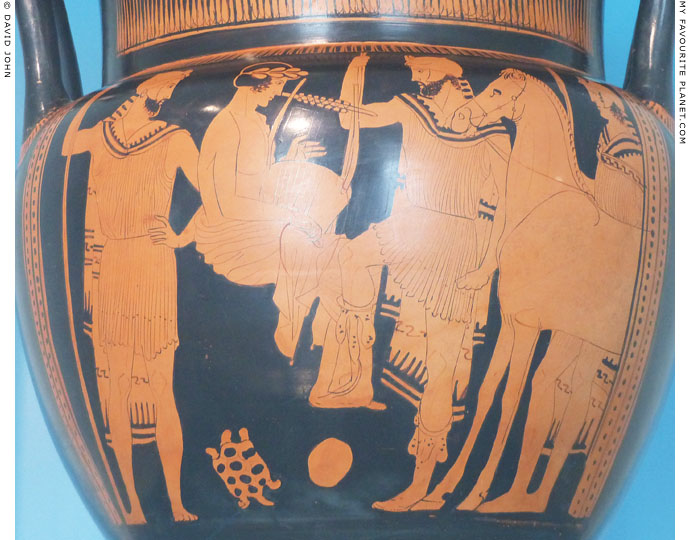
Orpheus playing his lyre among Thracians warriors, by the Painter of Naples, on an Attic red-figure
column krater, circa 450 BC. The general composition is similar to the painting of the same subject
on the name vase of the Orpheus Painter, also a red-figure column krater, made about the same
time. However, this version seems a little more formal and solemn. The painter has omitted the
rock on which Orpheus sits, but has introduced a horse, a tortoise and even a stone which has
been enchanted the bard's music.
Museum für Kunst und Gewerbe Hamburg. Inv. No. 1968.79. |
| |
Nessos Painter
Also referred to as the Nettos Painter.
Vase painter in Athens, active around 620-600 BC.
Originally named the Nettos Painter by Sir John Davidson Beazley, after the "Nessos Amphora", on which the name of the Centaur Nessos is inscribed Nετος (Netos). See images below. He was named the Nessos Painter by John Boardman, who also wrote that the Gorgon Painter was his pupil.
"I called the artist the Nessos Painter." John Boardman, Greek art, page 100 (mention of the Gorgon Painter on same page, caption to fig. 88). Thames and Hudson, London, 2012.
His style has been described as Late Protoattic or Early black-figure. He is thought to have been the first Athenian to adopt the Corinthian style. He developed his own style, introduced a number of innovations, and was a pioneer of Attic black-figure vase painting. It has also been suggested that he was the first Athenian vase painter whose work was traded internationally.
It has been suggested that works attributed to the Chimaera Painter (see photo below) may be early works of the Nessos Painter.
Named after the "Nessos Amphora", a large Archaic Attic black-figure amphora, circa 620-610 BC, found in Athens (see images below). The painting on the neck depicts Herakles fighting with the Centaur Nessos, with the inscribed names of the figures Ηερακλες (Herakles) and Nετ[τ]ος (Nettos). The body shows two winged Gorgons and the decapitated body of Medusa (see Medusa part 2). National Archaeological Museum, Athens. Inv. No. 1002 (CC 657).
A now lost fragmentary louterion (λουτήριον, wide spouted krater), also attributed to the Nessos Painter, was found in a well in the ancient city of Aegina, among other ceramic fragments, mostly of Corinthian pottery. Two of the inscribed painted panels from around the top of the vessel's body had survived. One showed Athena (name inscribed) standing behind Perseus (name inscribed) running or flying to the right in the "Knielauf" position, pursuing the headless Medusa and her two Gorgon sisters (figures missing). The other panel depicted two winged Harpies (inscription ΑΡΕΠΥΙΕ), running/flying to the right. Fragments of a lower band showed sphinxes and animals (horses, panthers, bulls). Height of louterion 28 cm, diameter 55 cm. State Museums Berlin (SMB). Inv. No. F 1682.
See: Adolf Furtwängler (1853-1907), Beschreibung der Vasensammlung im Antiquarium, Erster Band. Königliche Museen zu Berlin. Pages 220-221, No. 1682 (2636). W. Spemann, Berlin, 1885. At the Internet Archive.
Other vases and fragments attributed to the Nessos Painter include:
A fragmentary skyphos krater, circa 620 BC, from Vari, southwest Attica. Fragments on the body include parts of a depiction of Herakles freeing Prometheus, and the base shows a procession of women (see photos below). Height 110.6 cm. National Archaeological Museum, Athens. Inv. No. 16384.
An Attic black-figure belly amphora, circa 620-610 BC, found in the Athens Agora in 1932. The vessel is decorated on each side with a sphinx. Height 45.7 cm, width 34.5 cm. Museum of the Ancient Agora, Athens. Inv. No. P 1247.
Fragments of a skyphos krater from Athens, with parts of a depiction of Bellerephon and Chimaera. Kerameikos Archaeological Museum, Athens. Inv. No. 154.
A belly amphora depicting lions on the neck and griffins on the body. Height 79 cm. State Museums Berlin (SMB) Inv. No. 1961. |
|
|
| |
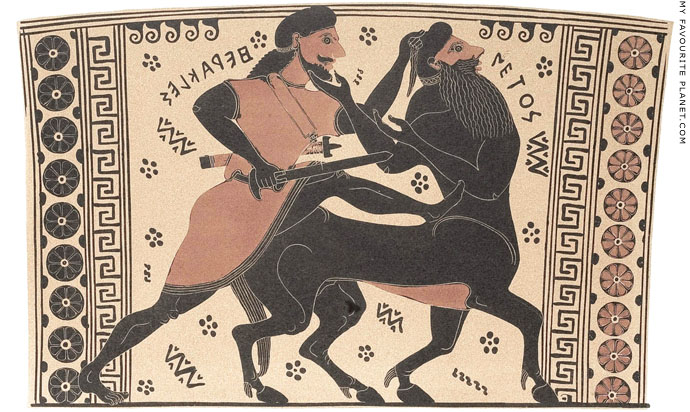
Herakles attacking the centaur Nessos with a sword on the neck of the Attic black-figure
amphora known as the "Nessos Amphora", the name vase of the Nessos Painter. The
names of the characters are inscribed to either side of the respective figure: Ηερακλες
(Herakles) written retrograde (backwards), and Nετος (Netos) for Nessos.
Circa 620–610 BC. Excavated in central Athens in 1890. Height 122 cm.
Watercolour by Émile Gilliéron (1850-1924).
National Archaeological Museum, Athens. Inv. No. 1002 (CC 657).
|
The "Nessos Amphora" was excavated in Pireaus Street, Keramaikos, central Athens in 1890. The painting on the body (belly) of the vase depicts two Gorgons and the decapitated body of Medusa (see Medusa part 2).
The Greek archaeologist Panagiotis Kavvadias (Παναγής Καββαδίας, 1850-1928), who excavated the amphora, believed it may have been a grave marker from the Late Geometric cemetery of the nearby Dilypon area. On the other hand, the German archaeologists excavating in Kerameikos thought it may have been from an "Opferrinne" (offering trench). The bones and ashes of sacrificed animals have been discovered in such trenches, often along with fine pottery, thought to have been buried after ritual meals.
There are several theories concerning the spelling of Nessos: the painter made an error, or came from Anatolia (Asia Minor) where the tau (T) letter-form is thought to have stood for double s; the name Nessos was pronounced Nettos in the Attic dialect.
One of the earliest known versions of the story of Herakles and Nessos was written by Sophocles in his play The Women of Trachis (lines 555-581). Deianeira, Herakles' wife, recalls how he killed Nessos (with an arrow) because the Centaur had tried to rape her. But even as he dies, Nessos plans his revenge on Herakles by tricking Deianeira. He tells her to keep some of his blood, and that a shirt dipped in it will win back Herakles' love, should he ever fall in love with another woman.
See also Nessos abducting Deianeira on an Attic black-figure lekythos, circa 600-580 BC, the name vase of the Deianeira Painter.
Source of images: Valerios Stais, Paul Wolters, Amphora aus Athen, in Antike Denkmäler Band I, pages 46-48 and plate 57. Kaiserlich Deutsches Archäologisches Institut. Verlag von Georg Reimer, Berlin, 1891. At Heidelberg University Digital Library.
See also:
Beazley Archive Database, Vase No. 300025 |
|
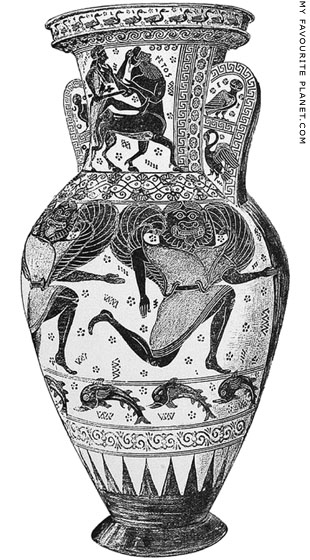
A reconstruction drawing of the front of
the "Nessos Amphora" by Émile Gilliéron. |
|
| |
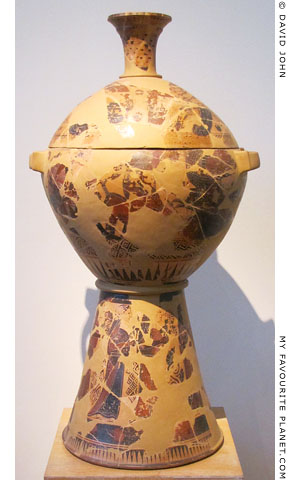 |
|
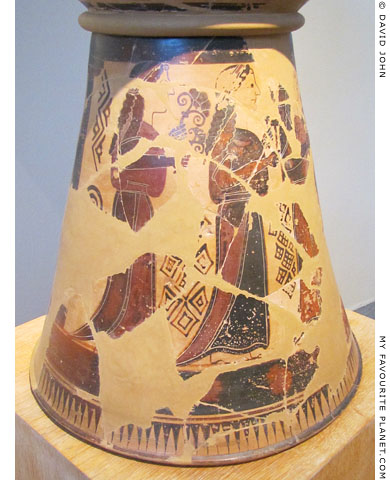 |
The restored fragments of an early black-figure skyphos krater
with paintings attributed to the Nessos Painter.
On the lid are two confronting lions. On the body Prometheus is chained to a
high post, and Herakles, who is about to free him, shoots an arrow at the eagle
tormenting him. On the base is a procession of women (photo above right).
Around 620 BC. From Vari, southwest Attica. Height 110.6 cm.
National Archaeological Museum, Athens. Inv. No. 16384. |
|
| |
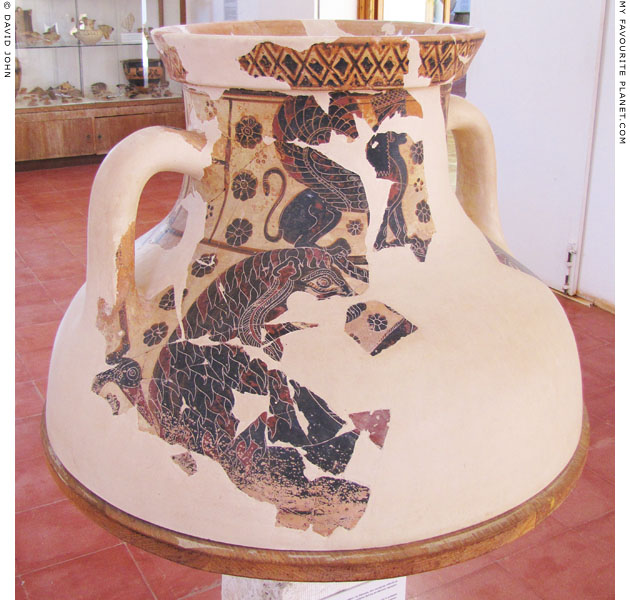
Fragments an Attic black-figure funerary amphora, attributed to the Chimaera Painter
by Sir John Beazley. Made around 620-600 BC, thought to be an early phase of the
Nessos Painter. On the neck are fragments of two confronted seated sphinxes, and
on the body fragments of two confronted chimaeras. Spaces are filled with rosettes
as well as stars of five red points. Height 34 cm, diameter 80 cm.
Aegina Archaeological Museum. Inv. No. 2812. |
| |
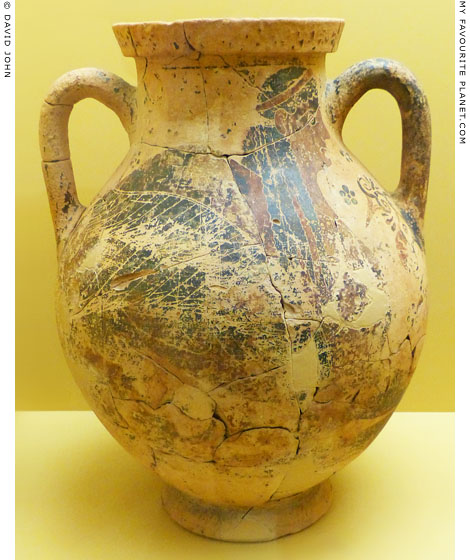
Restored fragments a Protoattic amphora with a scratched and worn
depiction of a Sphinx attributed to the Nessos Painter. 620-610 BC.
Agora Museum, Athens. |
| |
Nikosthenes
Νικοσθενες
Potter and painter in Athens, active around 545-510 BC.
150 examples of the signature Νικοσθενες έποίησεν (Nikosthenes epoiesen, Nikosthenes made it) are known (see photo below). That is around a quarter of all epoiesen signatures on extant Athenian vases, and thus the most common signature not only in Attic vase painting but in the whole of ancient Greek art. He is considered to have made and painted around 90 of the signed vases, even though he never signed Nikosthenes egraphsen (Νικοσθενες ἔγραφσεν, Nikosthenes painted it). The remaining signed pots were either made by him and painted by other artists, or made and painted by others. Of these, the signatures appear to be by various hands. It is thus thought that Nikosthenes was an owner of a pottery workshop, probably specializing in production for the Etruscan market, and that his signature was more akin to a trademark than just a personal autograph.
See: Jeffrey M. Hurwit, Artists and signatures in ancient Greece, pages 86-87. Cambridge University Press, 2015. |
|
|
| |
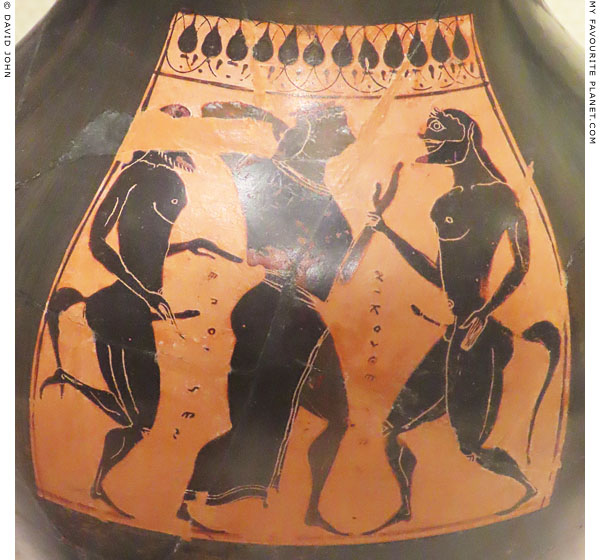
An Attic black-figure amphora with the signature of the potter Nikosthenes
(Νικοσθενες έποίησεν, Nikosthenes epoiesen, Nikosthenes made it) in a
painted panel depicting a Maenad dancing between two Satyrs.
Made in Athens round 550-540 BC. Excavated in a tomb in Vulci, Etruria, Italy.
Rijksmuseum van Oudheden, Leiden, Netherlands. |
| |
Potters and
vase painters |
O |
|
 |
|
| |
| |
Orpheus Painter
Red-figure vase painter in Athens,
active around 450 BC.
Named after "Orpheus among the Thracians", an Attic red-figure column krater, circa 450 BC, depicting Orpheus playing to a group of Thracian warriors. Discovered in Gela, southern Sicily. Berlin State Museums (SMB). Inv. No. V. I. 3172. |
|
|
| |
Potters and
vase painters |
P |
|
 |
|
| |
Polygnotos
Πολύγνωτος (also referred to as Polygnotos I)
Red-figure vase painter in Athens,
active around 450-420 BC.
He trained in the workshop of the Niobid Painter, and followed his master in painting mythical, religious and combat scenes. Considered one of the most important painters of the red-figure style of the High Classical period, he specialized in monumental vases, including kraters, hydria, stamnoi and shoulder amphorae, but also painted smaller pelike and Nolan amphorae. His signature has been found on five vases.
He led a workshop known as the Group of Polygnotos, including other painters whose names are known, to which around 700 vases have been attributed. Another two hundred vases by unnamed painters may also be products of the group.
Two other vase painters were named Polygnotos: an Early Classical painter of skyphoi, usually referred to as the Lewis Painter or Polygnotos II; and a "later Mannerist", known as the Nausicaa Painter.
An Attic red-figure stamnos, attributed to Polygnotos, circa 430-420 BC, depicting Theseus abducting Helen. National Archaeological Museum, Athens. Inv. No. 18063 (see photo below).
An Attic red-figure pelike, circa 450-440 BC, attributed to Polygnotos, with a finely drawn depiction of Perseus beheading the sleeping Medusa. One of the earliest depictions of Medusa as a beautiful young woman rather than a hideous monster. The other side shows King Polypeithes (named in the inscription, but not otherwise known) between two women.
Metropolitan Museum, New York.
Inv. No. 45.11.1.
An Attic red-figure stamnos attributed to Polygnotus, 450-430 BC, depicting the "Entrail Roaster" (σπλαγχνόπτης, splanchnoptes, man cooking intestines), in the British Museum. This scene may be related to the bronze "Entrail Roaster" statue by the Cypriot sculptor Styppax, which according to Pliny the Elder depicted a favourite slave of Pericles (Natural History, Book 22, chapter 20 and Book 34, chapter 19). |
|
|
| |
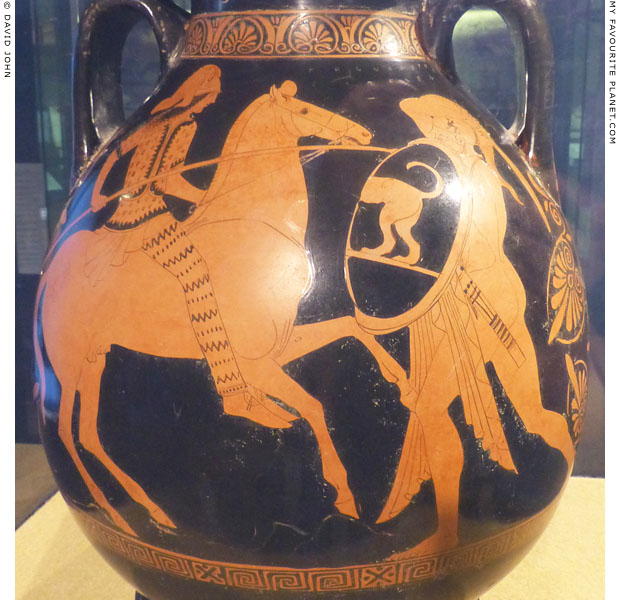
Detail of an Attic red-figure pelike showing an Amazon on horseback fighting a Greek warrior.
440-430 BC. From Gela, Sicily. signed by Polygnotos above the head of the warrior.
The other side shows two women and a man conversing.
Paolo Orsi Regional Archaeological Museum, Syracuse. Inv. No. 23507. |
| |
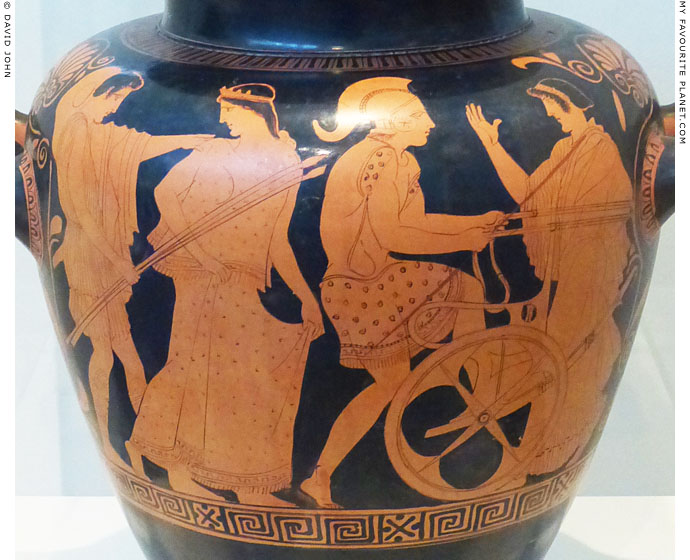
The first abduction of Helen by Theseus painted on an Attic red-figure
stamnos. Atributed to Polygnotos, around 430-420 BC.
On the left, Theseus leads Helen to the chariot already prepared
by Peirithoos. On the right, Phoibe, Helen's sister, sees her off.
Over the figures, inscriptions, once painted white, are discernible:
ΘΕΣΕΥΣ, ἙΛΕΝΕ, ΠΕΙΡΙ(Θ)ΟΣ, ΦΟΙΒΑ
Donated by the Kyriazis family. It was probably found in a
grave in Marathon and had been used as a funerary urn.
National Archaeological Museum, Athens. Inv. No. 18063. |
| |
Polyphemos Painter
(or Polyphemus Painter)
A high Proto-Attic vase painter and perhaps potter, active in Athens or on Aegina, mid 7th century BC.
He may have been a pupil of the Mesogeia Painter.Named after the "Eleusis Amphora", a large Proto-Attic amphora, dated to around 660 BC, discovered in Eleusis, Greece. The neck depicts Odysseus and his companions blinding the Cyclops Polyphemos, the body shows Perseus and the Gorgons. Eleusis Archaeological Museum. Inv. No. 2630. |
|
|
| |
Pourtalès Painter
Athenian late red-figure vase painter, around 380-360 BC.
A painter of Kerch style vases of the final phase of Attic red-figure pottery production, around 375-330/20 BC. The name of such vases is due to the fact that a large quantity of them were found at Kerch (ancient Pantikapaion), on the Black Sea coast of the Crimea. Most are now in the Hermitage Museum, Saint Petersburg.
A small number of vases have been attributed to Pourtalès Painter on the basis of style. He was named by John D. Beazley after the French-Swiss author Guy de Pourtalès (1881-1941), the former owner of a large, red-figure bell krater now in the British Museum. Side A shows the initiation of Herakles and the Dioskouroi into the Eleusinian Mysteries, with Demeter, Persephone, Triptolemos and other figures. Side B shows Dionysus, Plouton and Hephaistos with satyrs and maenads. Inv. No. GR 1865.1-3.14 (Vase F68).
See britishmuseum.org ...
A bell krater in Berlin, depicting Hermes and Herakles in the underworld, is also attributed to the Pourtalès Painter. Berlin State Museums (SMB). Inv. No. 31094. |
|
|
| |
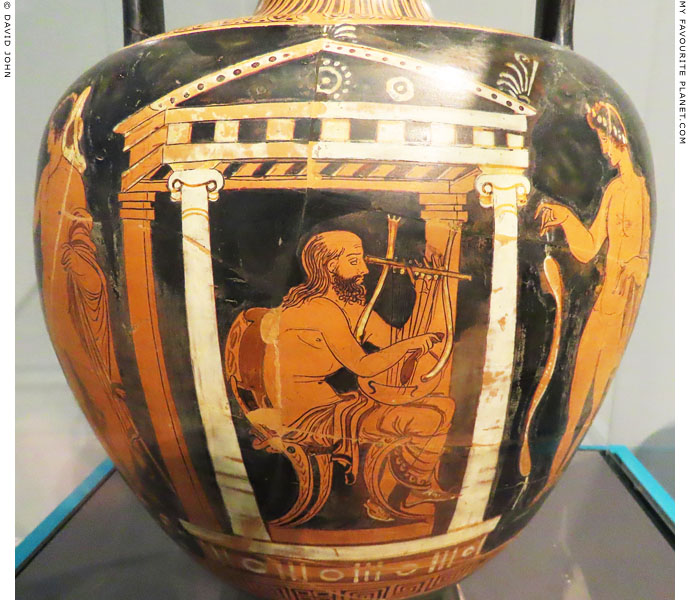
A red-figure amphora (shaped like a Panathenaic amphora) with a painting of an older,
bald musician or bard playing a lyre with a plectrum, seated in a small temple-like
building, flanked by two standing nude youths. On Side B are three draped men.
Made in Lucania (Λευκανία, Leukania), Magna Graecia (southern Italy), around 360 BC.
Attributed to the Primato Painter (flourished circa 360-320 BC), the leading artist of
a large workshop, and one of the last masters of Lucanian red-figure vase painting
(around 450-320 BC) before its decline. It was the earliest South Italian regional style,
influenced by the Attic tradition, and later by the techniques of neighbouring Apulia.
Height 58 cm, maximum diameter 33.5 cm (measured 2013).
Antikensammlung, State Museums Berlin (SMB). Inv. No. F 3155. Purchased 1827. |
| |
Psiax
Ψίαξ (signature ΦΣΙΑΧΣ, Fsiaxs)
Vase painter and potter in Athens,
active around 540-505 BC.
He was initially named the Menon Painter by John Beazley, after the potter's signature on a red-figure type A amphora in the Penn Museum, Philadelphia. Inv. No. 5399. However, by 1913 Beazley had already suggested that the amphora was by Psiax, and in 1934 Gisela M. A. Richter demonstrated that the Menon Painter and Psiax were the same person.
See: Gisela M. A. Richter, The Menon Painter = Psiax. American Journal of Archaeology, Volume 38, No. 4 (Oct. - Dec. 1934), pages 547-554. At jstor.
He painted black-figure vases, and played a major role in the early development of the red-figure technique, invented in the workshop of the potter Andokides around 530 BC. Some scholars credit Psiax with the invention.
He worked with the potters Hilinos, Menon, Andokides and Nikosthenes. His black-figure work is stylistically close to that of the Antimenes Painter, who worked for the same workshop.
He probably taught Euphronios and Phintias (Φιντίας).
Around 60 surviving vases, dated circa 525-505 BC, have been attributed to Psiax, mostly small vessels, but also large amphorae, hydriai and chalice kraters. Two of the works, both red-figure alabastra (Odessa Archaeological Museum and Badisches Landesmuseum, Karlsruhe), have his signature as well as that of the potter Hilinos. Three of the other vases are signed by the potter Andokides.
Many of the works are black-figure, but he also used other techniques, such as white-ground, coral red, and Six's technique (adding colours, white or red, on the black ground, and incised details), and was a pioneer of red-figure painting and even "bilingual" vases (decorated in black and red-figure). His main subjects were Dionysiac scenes, myths of Herakles, archers and horses. His painting style has been described as fine, lively, dignified and restrained.
Black-figure Attic plate by Psiax, 540-510 BC, with an armed warrior. Found in the Sanctuary of Zeus at Olympia. Altes Museum, Berlin. Inv. No. F 2099.
Beazley Archive Database No. 320364.
Other works attributed to Psiax are at: the British Museum; National Archaeological Museum of Spain, Madrid; Museo, Brescia; Metropolitan Museum, New York; J. Paul Getty Museum, Malibu; Philadelphia University Museum. |
|
|
| |
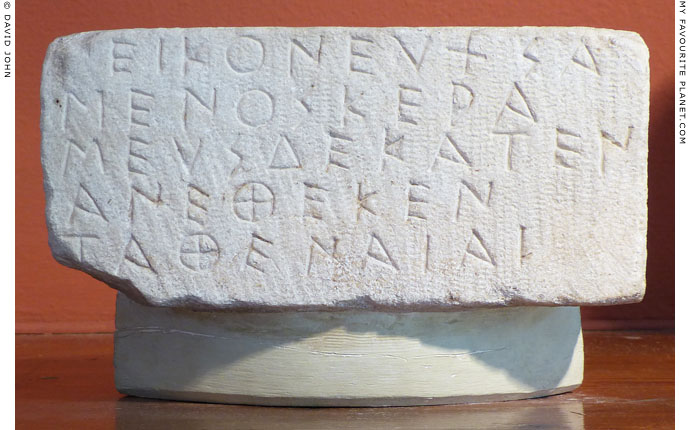
The inscribed upper section of a column for a dedication to Athena
set up on the Athens Acropolis by the potter Peikon (Πεικον).
Circa 540–480 BC.
Inscription: Antony E. Raubitschek, Dedications
from the Athenian Akropolis [DAA], No. 44.
Epigraphical Museum, Athens. Inv. No. EM 12750. |
| |
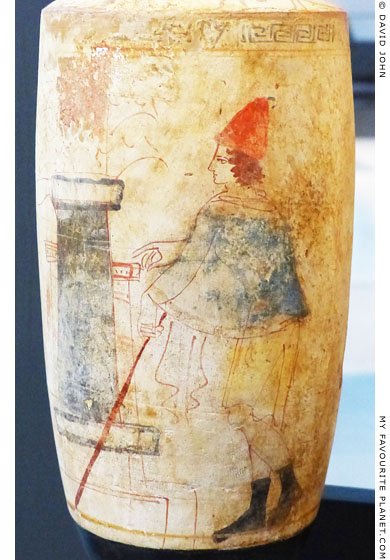
Detail of an Attic white-ground lekythos with a painting
of a warrior, wearing a red pilos and a blue chlamys
(short cloak), standing in front of a tombstone. To the
left of the tomb, not visible in photo, stand two females.
Around 420 BC. Attributed to the Reed Painter. One of
several objects found in a late 5th century BC tomb in
the northern cemetery of Pydna, Macedonia, Greece.
The deceased may have been a hetairos, a horseman
from the military aristocracy of Pydna.
Thessaloniki Archaeological Museum. |
| |
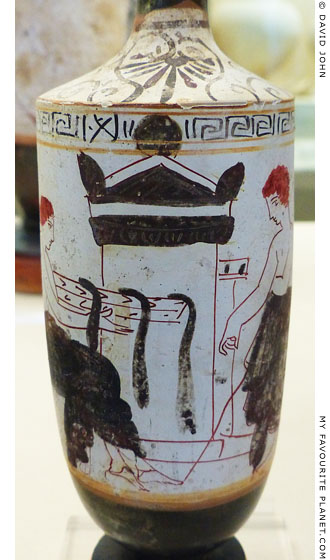
Detail of an Attic white-ground lekythos with
a painting of mourners in front of a tomb.
Around 450-400 BC. Attributed to the Reed Painter.
Found in the Kerameikos (T HS 195), Athens.
Kerameikos Archaeological Museum. |
| |
Potters and
vase painters |
S |
|
 |
|
| |
Sophilos
Σώφιλος
Potter and black-figure vase painter in Athens, active around 590-570 BC.
The earliest Athenian vase painter whose signature has survived and whose true name is known.
A follower of the Gorgon Painter.
37 vessels have been attributed to Sophilos, mostly amphorae, dinoi (wine bowls), kraters, as well as three pinakes (plaques). Four are signed by him as painter (ἔγραφσεν. egraphsen, painted it) and one as potter (εποιεσεν, epoiesen, made it). His work was made for the domestic market and for export to south Italy, the Black Sea, Syria and Egypt (Naukratis). Many of his works are influenced by the Corinthian style of vase painting, with bands or panels with paintings of rows of real and imaginary animals shown in profile.
An Attic black-figure column krater attributed to Sophilos, around 590 BC, depicting Herakles wrestling with Nereus in the presence of Hermes. National Archaeological Museum, Athens. Inv. No. 12587.
A large Attic black-figure dinos (wine bowl), circa 580 BC, with a depiction of a procession of deities attending the wedding of Peleus and Thetis, one of the earliest known encircling figure friezes. It is signed by Sophilos as painter: ΣΟΦΙΛΟΣ [...] ΜΕΓΡΑΦΣΕΝ (Sophilos [...] megraphsen, Sophilos drew me). British Museum. Inv. No. 1971,1101.1.
An Attic black-figure amphora, thought to be a late work of Sophilos, circa 580 BC, found at Marathon (see photo below). On the neck Hermes stands between two sphinxes (see the Hermes page). National Archaeological Museum, Athens. Inv. No. 1030.
An Attic black-figure loutrophoros, also made around 580 BC (see photo below). On the neck and body, zones with depictions of Sirens and animals. National Archaeological Museum, Athens. Inv. No. AR 991. |
|
|
| |
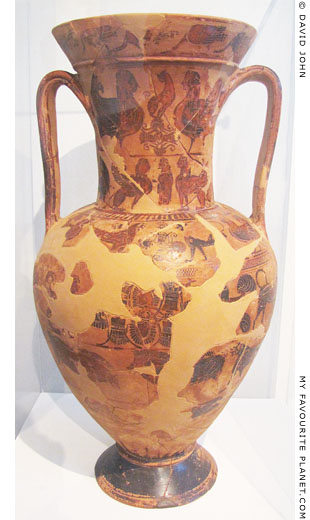
Restored fragments of an Attic black-figure amphora, a late work of Sophilos, circa
580 BC. On the neck, two confronting
Sirens, below which Hermes, holding a
kerykeion (caduceus), standing between
two sphinxes (see Hermes). On the body
are zones with depictions of winged Artemis,
animals, florals, sphinxes and geese.
Found at Marathon, Attica, Greece. The
most ancient of the many broken vases
found around the offerings ditch of the
tumulus of the Athenians who died
during the Battle of Marathon in 490 BC.
National Archaeological Museum,
Athens. Inv. No. 1030. |
|
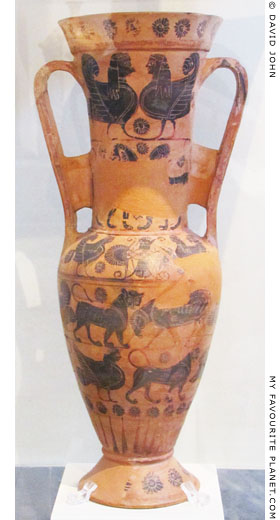
An Attic black-figure loutrophoros
(λουτροφόρος, used to carry bathwater)
with friezes of Sirens, animals and florals.
A late work of Sophilos, circa 580 BC.
Found at Vourva, Attica.
National Archaeological Museum,
Athens. Inv. No. AR 991. |
|
| |
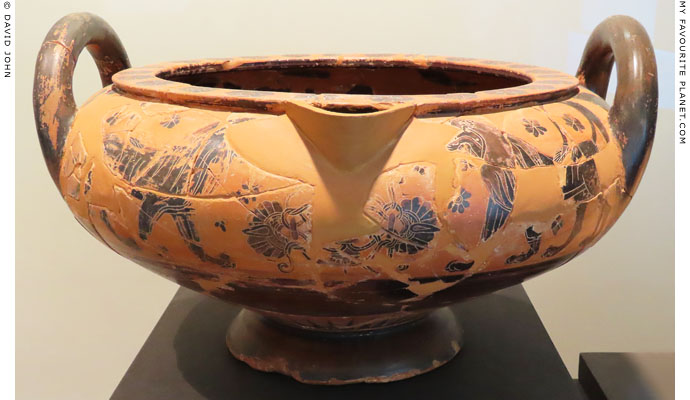
Restored fragments of an Attic black-figure louterion (λουτήριον, bowl
for washing), attributed to the workshop of Sophilos by John Beazley.
On this side of the vessel two confronting lions flank a floral pattern and two lotus
flowers arranged on a cross-shape. On the other side are three galloping horses
with riders, probably a horse race. Space is filled by rosette motifs. The flat rim of
the vessel's mouth is decorated with a row of rosettes. Its inside is painted black.
Made in Athens, around 590-580 BC. Found at the cemetery of the ancient city of
Korkyra (Κόρκυρα) in the modern Garitsa suburb of Corfu town (see Medusa part 3).
It had been placed near a large burial pithos containing burned bones.
Corfu Archaeological Museum. Inv. No. E61.09.
See: Beazley Archive Database, Vase No. 350106 |
| |
Sosias
Σοσιας
Potter in Athens, active around 510-490 BC.
Little is known about this potter. He has been identified by the signature Σοσιας εποιεσεν (Sosias epoiesen, Sosias made [me]) incised on the foot of an Attic red-figure kylix, circa 500 BC, now in the Berlin State Museums (SMB). Inv. No. F 2278. (see Sosias Painter below).
His incised signature is also preserved on the foot of another cup, the only part of the vessel to have survived, in Berlin. Inv. No. F 2315. |
|
| |
Sosias Painter
Red-figure vase painter in Athens, active around 510-490 BC.
Presumably working in the workshop of the potter Sosias.
His style resembles later works of Euphronios, and he may have worked with him. He is thus also thought to have been a member of the Pioneer Group of early red-figure painters.
The Sosias Painter was named by John Beazley after an Attic red-figure kylix (drinking cup), made around 500 BC, signed Σοσιας εποιεσεν (Sosias epoiesen, Sosias made [me]). The signature is thought to be that of the potter Sosias rather than the painter. The painting on the tondo inside the cup depicts "Achilles binding Patroklos" (see Homer part 2). On the outside is a depiction of the Apotheosis of Herakles (see image below). Found by Fossati in 1828 in the Necropolis Campo Scala, Vulci, Italy. Altes Museum, Berlin. Inv. No. F 2278. |
|
|
| |
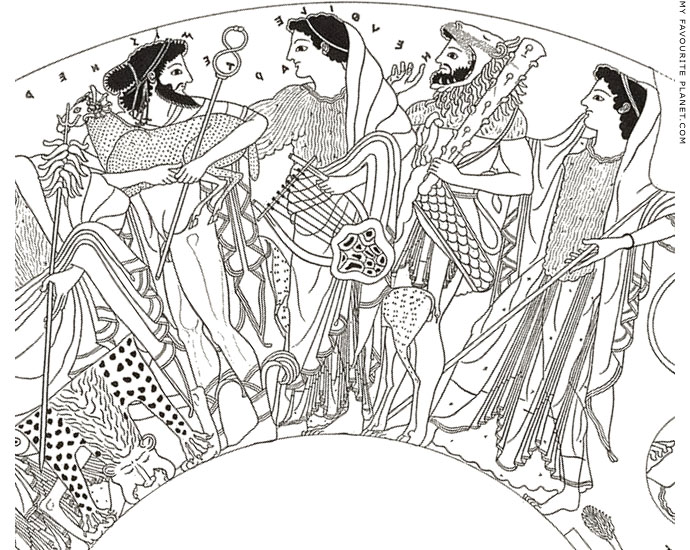
The Apotheosis of Herakles on the outside of an Attic red-figure kylix (κύλιξ, stemmed
drinking cup) made by the potter Sosias and painted by the Sosias Painter.
Athena (far right) presenting her protegé, the semi-divine hero Herakles,
son of Zeus, to an assembly gods on Mount Olympus. The figures (left-right):
Hermes, Artemis, Herakles (names inscribed) and Athena with a spear.
The painting on the inside of the kylix depicts Achilles binding Patroklos' wound.
Around 500 BC. Signed by the potter Sosias on the rim of the foot: Σοσιας εποιεσεν
(Sosias epoiesen, Sosias made [me]). It is the name vase of the Sosias Painter.
Found by Fossati in 1828 in the Necropolis Camposcala, Vulci, Etruria (Lazio, Italy).
Height 10 cm, diameter (mouth) 32 cm.
Altes Museum, Berlin. Inv. No. F 2278. Acquired in 1831.
Drawing by G. van Geldern. Source: Fraenkel, Schale und Untersatz des Sosias
im Berliner Museum, in Antike Denkmäler Band 1, page 4 and plate 9.
Kaiserlich Deutsches Archäologisches Institut. Georg Reimer, Berlin, 1891. |
| |
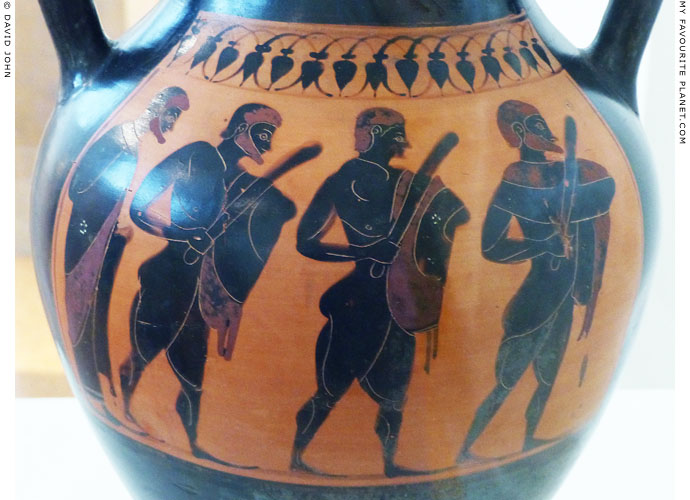
Detail of an Attic black-figure amphora showing three men walking with clubs, thought to depict
bodyguards of the 6th century BC Athenian tyrant Peisistratos (Πεισίστρατος). Herodotus related
an anecdote in which Peisistratos tricked the Athenians into giving him a personal guard, whom
he made "clubmen instead of spearmen" and used to seize the Acropolis and make himself ruler
of the city. (The Histories, Book 1, chapter 59. At Perseus Digital Library)
Side B shows a duel between to armed men (see below).
Made in Athens, 530-525 BC. Painting by the Swing Painter.
National Archaeological Museum, Athens. Inv. No. 15111. |
| |
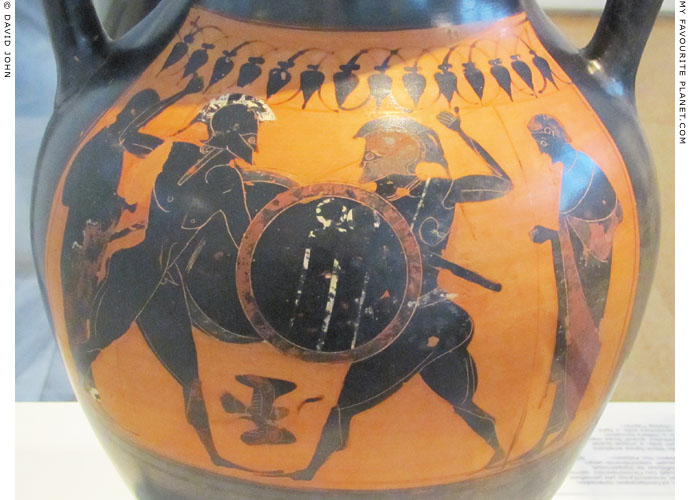
Side B of the amphora by the Swing Painter above, with a depiction of two armed men duelling.
They are shown in profile, with their upper torsos twisted to face the front. Each has one arm
raised and holding a spear. They both wear crested Corinthian helmets and scabbards, and
carry round shields. The shield of the combatant on the right has a white tripod device. The
man on the left is naked, while the other wears a corselet. A bird of prey flies between them,
carrying a victor's headband in its beak. On either side stands a draped man holding a spear.
Made in Athens, 530-525 BC. Painting by the Swing Painter.
National Archaeological Museum, Athens. Inv. No. 15111. |
| |
Syleus Painter
Red-figure vase painter in Athens, active around 490-470 BC.
Fifty one works have been attributed to the Syleus Painter, named after a red-figure stamnos in Copenhagen depicting Herakles fighting Syleus.
An Attic stamnos, 480-470 BC, showing Dionysus, holding a drinking horn, with two dancing maenads. Pergamon Museum, Berlin. Inv. No. F2182.
An Attic black-figure kalpis (κάλπις, type of hydria) showing Zeus handing the infant Dionysus to the nymphs. Around 480 BC. From Agrigento, Sicily. Cabinet des Medailles, Paris. Inv. No. 440. Height 38.2 cm, width 43 cm. |
|
| |
Syriskos Painter
Red-figure vase painter in Athens, active around 480 BC.
An Attic red-figure calyx-krater, circa 480 BC, from the Athens Acropolis, attributed to the Syriskos Painter, showing Theseus fighting the Minotaur in the Labyrinth. National Archaeological Museum, Athens. Inv. No. Acr. 735. |
|
|
| Photos and articles © David John, except where otherwise specified. |
 |
Visit the My Favourite Planet Group on Facebook.
Join the group, write a message or comment,
post photos and videos, start a discussion... |
|
|
| |
|
|
| |
| |
 |
| |
 |
| |
 |
| |
 |
| |
 |
| |
 |
| |
George Alvanos
rooms in
Kavala's historic Panagia District
Anthemiou 35,
Kavala, Greece
kavalarooms.gr
|
| |
Olive Garden Restaurant
Kastellorizo,
Greece
+30 22460 49 109
kastellorizo.de
|
| |
Papoutsis
Travel Agency
Kastellorizo,
Greece
+30 22460 49 286
greeklodgings.gr
|
| |
|